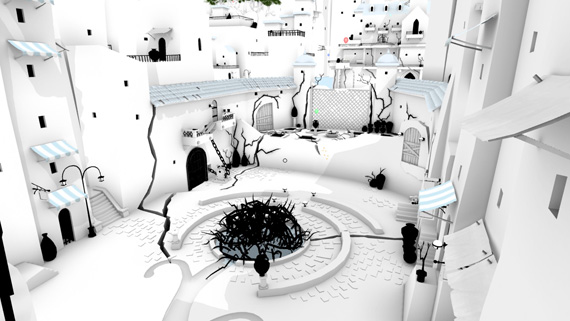
A storybook framework introduces players to Monroe, a young boy left alone, with only a single unfinished painting to remember his mother by – the unfinished swan that serves both as the game’s title, and as the breadcrumbs soon leading players through the looking glass, or canvas in this case, as the swan wanders off into the unseen space of the painting one fateful night.
As emotional charged as the premise sounds, explaining the digital offering is a challenge – another one of those Move titles you’d be better served by picking up and experiencing firsthand rather than reading my scribbles on the subject.
Though I’m obviously going to scribble about it anyway.
The game offers no tutorials or guidance to start the exploration either, which is confusing for all of two seconds as players find themselves holding the Move controller and staring into a blank white space.
At least, it should only take a second or two before you press the button that causes Monroe to use his brush, tossing a gob of paint into the void to find it quickly splatter against the environment that secretly surrounds you.

That first gob of paint reveals a secret world as it smacks black against a tree line, or perhaps hits a frog that then hops into an invisible pool of water. Tossing paint in every conceivable direction quickly shows a path around the rocks and trees and encourages a spirited rain dance at first.
But it’s the contrast that brings this world to life, since a bucket full of paint has a habit of transforming the environment into a depressing black void. Restraint along the way creates a magical trail of half revealed objects and strange statues as players make their way toward a kingdom built by the absent King at the heart of this story. And the way forward is kept clear by narrow pathways and the recurring yellow footprints of the swan leading Monroe deeper into this storybook world.
The game could have been content to stop here, repeating the formula by asking players to paint their way through a handful of stages with a clever use of the Move controller and then wonder how such a game didn’t come into existence much earlier on the Nintendo Wii. But players will reach the kingdom to find much of it already defined by minimalist lines and a few precious dabs of color. And as the black paint changes to evaporating splashes of blue water and players use it less to define the environment and more to search out paths between walls, the role of the brush shifts as the game moves from simple exploration toward light puzzle-solving and small feats of agility.

At times, players will use the blue water to encourage vines to grow throughout the environment, which chase after the paint to create a means of climbing to new heights while scaling toward the top of this kingdom. Jumping between vines and ladder rungs, the game will lock players to both until they choose to let go in order to keep the use of the Move controller from feeling like a crippling punishment throughout the emerging jungle gym.
Beyond the kingdom is a final world of darkness, where the emphasis will shift once again, with players seeking out and moving objects that emit light in order to protect themselves from creatures lurking in the shadows.
This is the only spot where the game risks frustration, particularly where players are asked to move a physical object by pushing it, mostly because said object doesn’t always want to co-operate. This is also the area where the game allows players to create 3D pillars to continue their ascent toward the King, who sits in his chamber with his pet hippo.

The game uses strict pathways to help keep players from wandering off the trail – as spacious as some areas feel, there’s really no room to get overly lost in. But it could still prove difficult to know what the game intends players to do next even with such limited abilities granted to them, and the minimalist design helps point the way forward without having to draw giant arrows all over the place.
The simple controls allow players to use the Move controller with four buttons – moving forward and/or backward, throwing paint, and jumping. And this makes using the Dualshock controller as an alternative just as easy as navigating any first person shooter, with the same targeting reticule present as with the Move controller, showing where the paint will land.
Explaining the fundamentals of how one plays is several shades easier than convincing you of the emotional experience. The short nature of the game encourages an unbroken playthrough, while collecting balloons for a few unlockables doesn’t quickly insist upon a revisit. The Unfinished Swan captures a mix of mysterious adventure and sweetly sorrowful sentimentality to successfully adapt the spirit of childhood storybooks to the gaming medium, continually pushing to introduce clever challenges for players as they guide Monroe toward a resolution with his life that caught me off guard when reaching the game’s final moments.
Artistically charged with a spirit of imagination, The Unfinished Swan doesn’t quite channel the spark of the divine that Journey did earlier this year, but does offer an equally touching experience that finds it sitting comfortably with Sony’s growing collection of digital titles that demand more conversation over explanation.
Giant Sparrow
Publisher
Sony Computer Entertainment
System
PlayStation 3 (PlayStation Network)
Modes
Singleplayer
Release Date
October 23, 2012
Price
$14.99
*A copy of this title was provided by the publisher for review

I’m waaay behindon my gaming. Need to give this game a try before the year is over!
Comment by EdEN — October 30, 2012 @ 4:22 pm